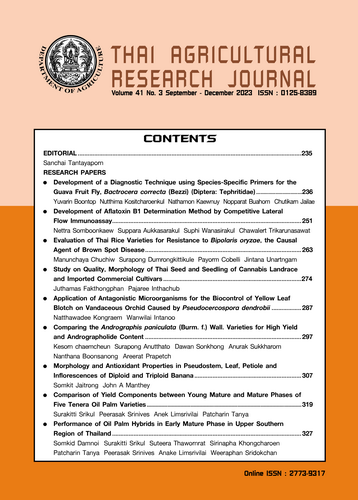Comparison of Yield Components between Young Mature and Mature Phases of Five Tenera Oil Palm Varieties
DOI:
https://doi.org/10.14456/thaidoa-agres.2023.27Keywords:
fresh fruit bunch, bunch number, average bunch weight, production phaseAbstract
This study aimed to evaluate the yield performance of five Tenera varieties during the young mature and mature phases with the objective of identifying high-yield planting materials. The assessment was conducted at Golden Tenera Limited in Krabi, Thailand, using a randomized complete block design with three replicates. The oil palm trees were spaced 9.0 meters in a triangular pattern. This study spanned from 2009 to 2023, allowing for acomprehensive analysis of yield performance over a significant time period. The findings revealed that the mature phase, spanning from 6 to 11 years after planting, exhibited higher values for fresh fruit bunch (FFB) at 260.18 kg/palm/year and average bunch weight (ABW) at 16.62 kg/bunch/ year. Conversely, the young mature phase, ranging from three to five years after planting, displayed a higher bunch number (BNO) of 25.20 bunches/palm/year. Among the 5 evaluated Tenera varieties, V4 demonstrated the highest values for FFB at 244.12 kg/palm/year and BNO at 22.90 bunches/palm/year. Furthermore, V4 consistently exhibited the highest FFB and BNO values in both young mature and mature phases. The findings of this study will improve the selection and cultivation of productive Tenera varieties, boosting their efficiency and productivity in palm oil plantations.
References
Arolu, I.W., M.Y. Rafii, M. Marjuni, M.M. Hanafi, Z. Sulaiman, H.A. Rahim, O.K. Kolapo, M.I.Z. Abidin, M.D. Amiruddin, A. Kushairi and N. Rajanaidu. 2016. Genetic variability analysis and selection of pisifera palms for commercial production of high yielding and dwarf oil palm planting materials. Industrial Crops Prod. 90: 135-141.
Corley, R.H.V. and B.S. Gray. 1976. Growth and yield components. pp. 77-86, In: R.H.V. Corley, J.J. Hardonand B.J. Wood, (eds.).Oil Palm Research Elsevier, Amsterdam.
Corley, R.H.V. and P.B. Tinker. 2016. The Oil Palm, 5th ed. Willey Blackwell Publ. Co. Inc., USA. 680 p.
Fairhurst, T. and R. Härdter. 2003. Oil palm: management for large and sustainable yields. PPI, PPIC, Singapore, IPI Basel, Switzerland.
FAOSTAT. 2023. The Food and Agriculture Organization Database. Available at: http://www.fao.org/faostat/en/#data/QC. Accessed: May 5, 2023.
Gingold, B., A. Rosenbarger, Y.I.K.D. Muliastra, F. Stolle, I.M. Sudana, M.D.M. Manessa, A. Murdimanto, S.B. Tiangga, C.C. Madusar, and P. Douard. 2012. How to Identify Degraded Land for Sustainable Palm Oil in Indonesia. Work. Pap. World Resour. Inst. Sekala, Washingt. D.C. Available at: http// wri.org/Publ. Indones. WRI/SE, Accessed: May 5, 2023.
Hartley, C.W.S. 1988. The Oil Palm. London: Longmans, Green. 761 pp.
Junaidah, J., M.Y. Rafii, C.W. Chin and G. Saleh. 2011. Performance of tenera oil palm population derived from crosses between Delidura and pisifera from different sources on inland soils. J. Oil Palm Res. 23(30): 1210–1221.
Kushairi, A., A. Mohd Din and N. Rajanaidu. 2011. Oil palm breeding and seed production, pp. 47-101. In: M. B. Wahid, Y.M. Choo and K.W. Chan eds. Further Advances in Oil Palm Research, Vol. 1, Malaysian Palm Oil Board, Kuala Lumpur.
OAE. 2023. Agricultural Statistic of Thailand 2022. Office of Agricultural Economics, Ministry for Agriculture and Cooperatives. Bangkok, Thailand. (in Thai)
R CoreTeam.2022. R: A language and environment for statistical computing. R Foundation for Statistical Computing, Vienna, Austria. Available at: https://www.R-project.org/. Accessed: December 18, 2022.
Rafii, M.Y., Z.A. Isa, A. Kushairi, G.B. Saleh and M.A. Latif. 2013. Variation in yield components and vegetative traits in Malaysian oil palm (Elaeis guineensis jacq.) dura×pisifera hybrids under various planting densities. Ind. Crop. Prod. 46: 147–157.
Rajanaidu N., A. Kushairi, M. Rafii, A. Mohd Din, I. Maizura and B.S. Jalani. 2000. Oil palm breeding and genetic resources, pp. 171- 237. In: Y. Basiron, B.S. Jalani and K.W. Chan, eds. Advances in oil palm research, Vol. I, Malaysian Palm Oil Board, Kuala Lumpur.
Rao, V., P. Tittinutchanon, C. Nakharin and R.H.V. Corley. 2008. The Univanich oilpalm breeding programme and progeny trial results from Thailand. Planter. 84(989): 519–531.
USDA. 2023. Oil Seeds: World Markets and Trade. United States Department of Agriculture Foreign Agricultural Service. Available at: https://apps.fas.usda.gov/psdonline/circulars/oilseeds.pdf. Accessed: May 5, 2023.
Woittiez L.S., M.T. van Wijk, M. Slingerland, M. van Noordwijk and K.E. Giller. 2017. Yield gaps in oilpalm: A quantitative review of contributing factors. Eur. J. Agron. 83: 57-77.
Wongsri, O., K. Thanarak, S. Srikul, C. Chawana, V. Omzubsin, Y. Riyapan, S. Promchue and S. Kolasuek. 2019. Breeding of oil palm for high yield: hybrid variety Suratthani 7. Thai Agric. Res. J. 37: 78-92. (in Thai)
Downloads
Published
How to Cite
Issue
Section
License
Copyright (c) 2023 Thai Agricultural Research Journal

This work is licensed under a Creative Commons Attribution-NonCommercial-NoDerivatives 4.0 International License.
Thai Agricultural Research Journal



